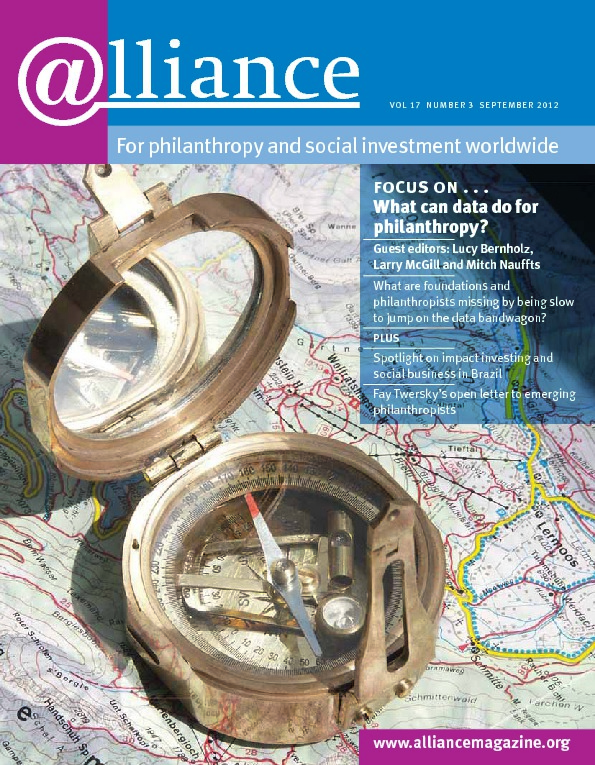‘For data to be useful in philanthropy they have to be known, accessible, and compoundable (able to be mixed and combined).’ So wrote Lucy Bernholz in a post on her Philanthropy 2173 blog in July. The following resources and examples, from philanthropy and beyond, are intended to help you think about your data in new and more interactive ways.
Examples from the field
Data analysis and visualization applied to a range of traditional foundation activities, from evaluation to communicating issues of concern to tracking the nation’s health.
Annie E Casey Foundation: KidsCount Data Center
http://datacenter.kidscount.org
One of the first rich, data-driven applications from a foundation; provides access to hundreds of measures of child well-being in the US, by and across states and in a mobile format.
Bill & Melinda Gates Foundation: Infographics
http://www.gatesfoundation.org/infographics/Pages/infographics.aspx
Information graphics designed to help explain the aims and impact of the foundation’s work, from vaccine delivery to supporting women farmers in developing countries.
California HealthCare Foundation: Medical Variation Rates
http://www.chcf.org/publications/2011/09/medical-variation-rates-california
Interactive map that presents, in multiple formats, elective surgery and other procedure rates across California relative to state averages.
Robert Wood Johnson Foundation: County Health Rankings & Roadmaps
http://www.countyhealthrankings.org
Based on a model of population health that emphasizes the many factors that can help make communities healthier places to live, learn, work and play; ranks the health of nearly every county in the US.
WASHfunders.org
http://washfunders.org
Interactive map that allows users to see who is funding WASH strategies around the world, with results filterable by country, strategy and other indicators.
Other examples
Climate and Development Links (World Bank)
http://climate4development.worldbank.org
Interactive map that allows users to explore the difference between two climate change scenarios that assume different development pathways and associated greenhouse gas emissions.
Gay Rights in the United States (Guardian newspaper)
http://www.guardian.co.uk/world/interactive/2012/may/08/gay-rights-united-states
Interactive graphic that shows how the handling of gay rights varies by state.
OECD Better Life Index
http://www.oecdbetterlifeindex.org
Interactive tool that allows users to see how OECD countries perform according to the importance the user gives to each of 11 factors that contribute to well-being and a better life.
Opportunity Gap (ProPublica)
http://projects.propublica.org/schools
Searchable database of all public schools in districts with more than 3,000 students; allows parents and others to explore how states do in providing poor and wealthier schools equal access to advanced classes.
Related resources
Center for Digital Information Dashboard
http://digitalinfo.org/showcase
Highlights innovative examples of the changing form of information in the digital age, with examples drawn from journalism, publishing, research, government and elsewhere
DataKind
http://datakind.org
Formerly known as Data Without Borders, DataKind brings together leading data scientists with high-impact social organizations.
Drawing by Numbers
Created by the Berlin-based Tactical Technology Collective, this site offers open-source software tools to help you make your own charts, maps and mashups; advice on the tactical use of data and visual communication for activists; and online manuals, toolkits and tutorials.
Flowing Data
Nice list of data visualization-related blogs curated by Nathan Yau, a PhD candidate in statistics at UCLA.
Gapminder
http://www.gapminder.org
‘Fact tank’ founded by Swedish doctor, academic and statistician Hans Rosling to promote a fact-based view of sustainable global development and achievement of the UN Millennium Development Goals.
Google Charts | Fusion Tables
https://developers.google.com/chart
http://www.google.com/fusiontables
Charting tools from search giant Google make it easy to merge public data with your own and display it all live on your website.
Many Eyes
http://www-958.ibm.com
Data visualization tools and examples from IBM Research and the IBM Cognos software group.
Mapbox
http://mapbox.com
Project of Development Seed, a creative data visualization team based in Washington DC; allows users to create and publish fast, interactive maps for web and mobile devices.
Tableau Public
http://www.tableausoftware.com/public
Free data visualization tool that allows users to create interactive visualizations from their data and embed them in a website.
Visualizing.org
http://visualizing.org
Self-billed as ‘a community of creative people making sense of complex issues
through data and design’.
This list of resources and examples was compiled by Jeff Stanger, founding director of the Center for Digital Information. Email jeff@digitalinfo.org.





Comments (0)